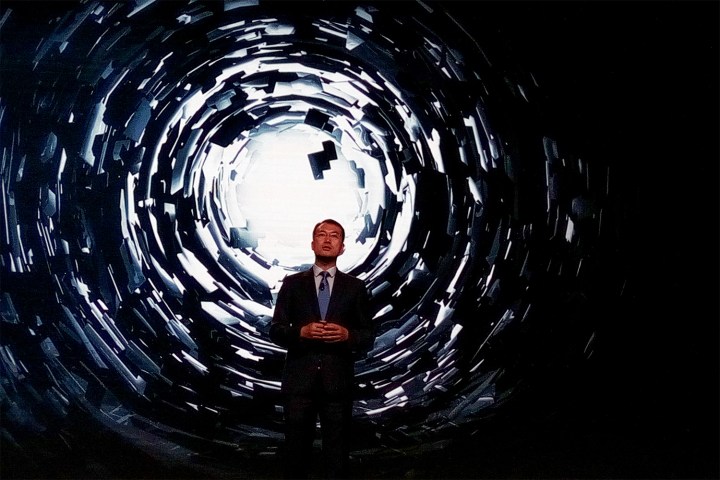
Life today would be unimaginable for people from a few decades or a few centuries ago, explained Ho, President of Huawei’s handset line, speaking Wednesday morning at the CES Asia 2016 event in Shanghai, China. Just imagine trying to explain ships and trains and even airplanes, all of which would have been terrifying to someone from 10,000 years ago. Then imagine bringing that same person to the modern world.
“What if coming to today’s society, somebody showed you a black box — a smartphone — with video phone functionality? What would people from ancient society think knowing that we can fly?” he asked the crowd.
Change of that nature can be quantified on a scale, Ho explained, calling it “the scary index.” Just how scary is modern life to someone from a different era? The rate of change (the scariness?) has accelerated in recent years, Ho explained, meaning that what might be possible in just a few short decades may be even more astounding. And frankly, just as horrifying.
“What technology when we see it will we be scared to death just to think about it?”
Ho used the opening keynote to the Consumer Technology Association’s Asian event to walk through where smartphones may go in the future, places some may find “totally unimaginable.” he said it wasn’t all that scary. You be the judge.
“In the future, there will be another you living in the parallel digital world.”
“In the future, there will be another you living in the parallel digital world, no matter if the flesh exists.”
Get that bit at the end? The translation is a little garbled, but Ho meant that we could live on after death in this virtual world. He described a scenario in which kids may speak to their grandparents as if they were still with us. Purchase the right upgrades and you can enable or transform your virtual self with all sorts of features. Immortality is just one of them.
Ho called it “spiritual immortality” – and we could get there by 2025, or maybe 2040 at the outset. Scared yet?
Lots of technology advancements are required to get there. We currently track many data points, including how many steps we take, what we weigh, pictures of us and the world around us, and so on. These let us build that virtual world, and explain why it mostly mimics the world around us. For it to be its own construct, like something pulled from The Matrix, would require huge leaps forward in many fields.

Ubiquitous connectivity and dramatically increased access speed will be necessary, of course. He pictured a 3,000 Gpbs peak connection speed in ’40, up from 1Gbps right now, and 15,000 zetabytes of data storage worldwide – up from 10 today. And Ho cited the need for increased vigilance on the security front as well. After all, artificial intelligence will continue to take steps forward, and we’ve all seen what happens in the movies when that happens. (Really. That’s what he said.)
Ho was making an extreme point, of course. Technology predictions never seem to come true, and looking back, the more farfetched they are, the more we like to make fun of the prognosticator.
But he was doing so for a reason. All of the areas he cited are fields into which the company is pouring its R&D efforts and dollars. There are 4.5 billion connections to the internet right now; there will be 100 billion by 2025, and 100 trillion by ’40. Likewise, there are about two IoT devices per person today. There will be 256 by 2025, he claimed, and as many as 1,000 per person in 2040.
“Technology development cannot be stopped.”
Huawei has invested $37 billion in R&D over the last 10 years to find some answers, he said. There are several areas of focus for the company, including technology ecosystems and the IoT space (of course). Everyone wants a part of the smarthome, Ho acknowledged. But progress has been slow.
“We’ve been talking about it for years, but progress is not unfolding at a rapid enough pace,” he told the crowd.
The company is working with many technology partners to build open platforms for the future. Huawei also is investigating health, the smart home, sports and medicine and more.
One surprise: an investment in the smart car space, and the artificial intelligence that will make it possible. The company is working with several very well known companies, he said, citing Volkswagen and others he wasn’t able to reveal. A later slide cited around a dozen other partners for various initiatives, companies with which Huawei is in a “very tight relationship,” including Audi.
There’s VR and AR as well. Huawei recently launched an open platform that they are talking to several partners about. Ho described virtual reality as “a portal or window leading us to the future.”
Let’s see how scary that future turns out to be.


